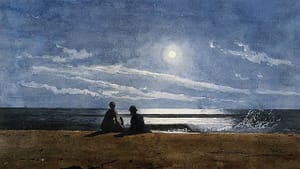Stay in the Loop
BSR publishes on a weekly schedule, with an email newsletter every Wednesday and Thursday morning. There’s no paywall, and subscribing is always free.
Obsession as a lifelong project
Charles Dubow's 'Girl in the Moonlight'

Charles Dubow's first novel, Indiscretion, prompted several reviewers to wheel out comparisons to F. Scott Fitzgerald's work. Accordingly, the dust jacket of his newly issued second book is decorated with phrases like “homage to Gatsby” and “Jazz Age glamor.” That second novel, Girl in the Moonlight, is likely to draw more comparisons to Fitzgerald, apt or not, despite this story’s reaching into the age of AIDS. Like Gatsby, Dubow's story is one of decades-long obsessive love, a love perhaps only possible on the top, most self-indulgent rungs of society.
Like Dubow himself, narrator Wylie Rose is an Upper East Side product of childhood summers in pricey places where he rubbed elbows with other wealthy kids. Among Wylie's young friends are the talented and beautiful Bonet children. The eldest of the Bonets is Francesca, stunning even at 13 with scabby knees. When “Cesca” is introduced to 11-year-old Wylie, her siblings are challenging him to climb onto a low roof from a tree limb. Unfortunately, Dubow's narrator ends up breaking his arm attempting to impress the budding beauty, but he is off and running emotionally on Project Cesca.
This book is principally about obsession, but along the way Dubow illuminates a number of other matters, among them the protection money Wylie provides for the directionless, the natural privilege of great beauty, and everywhere the wealthy habit of brand name-dropping (a ’63 Alfa Romeo Sprint Speciale, suits from Huntsman, shoes from Lobb).
What Dubow does well, however, is handle the psychology of the privileged, and particularly the nature of obsession.
As it turns out, Cesca is not quite as talented as her artistic and scientific siblings and definitely not as focused as any of them, but that's not to say she's dim. As she reaches college age, she is able to mount a reasonable defense for her wildness: “The thought of devoting myself to one thing, even to something I love, seems so final. I mean, what if it's not what I end up doing? Why waste all that time? It's so forced, so artificial. Making people decide about the direction of their lives so early.”
How obsession is revealed
Even better, though, is Dubow's portrayal of Wylie's obsession. The narrator doesn't see the object of his love for years at a stretch, but Cesca is never really out of his thoughts. Although Wylie and Cesca are intermittent lovers and Wylie's descriptions of their lovemaking lovingly rendered, it is Wylie’s imagining of Cesca's lovemaking with others that reveals the depth of his obsession. He covers himself by explaining that he is filling in his love's story with details she or relatives later gave him, but there is no way that Cesca ever shared with anyone the precise descriptions of her sexual escapades, particularly her first experience as a teen. Wylie's descriptions of those sessions are the objective correlatives of Obsession with a capital “o.” The sexual root of that mental defect is the one matter Wylie never quite understands as well as his creator.
Of course, even among the wealthy, life purposes aside from sexual love must be found, and Wylie eventually becomes an architect, after an extended shot at painting and then some very expensive graduate schooling. Cesca's youthful wildness, however, becomes aimless wandering by her late 20s as she enchants numerous men and even causes Wylie to hurt badly a perfectly wonderful woman who falls in love with him. Cesca marries once, divorces, stumbles from job to job and party to party, basically insulated by her money.
The reader wonders for much of the book whether either Wylie or Cesca will grow up. Despite his obsession, it seems throughout as though Wylie probably will, and he does; what's always in doubt, though, is how much damage Cesca’s existence will cause. In Cesca's case, a final change in her life course will strike some as unconvincing; others will see it as predictable as the reaction to pulling back a slingshot.
What, When, Where
Girl in the Moonlight by Charles Dubow. William Morrow, 2015. Available from Amazon.com.
Sign up for our newsletter
All of the week's new articles, all in one place. Sign up for the free weekly BSR newsletters, and don't miss a conversation.

 Rick Soisson
Rick Soisson